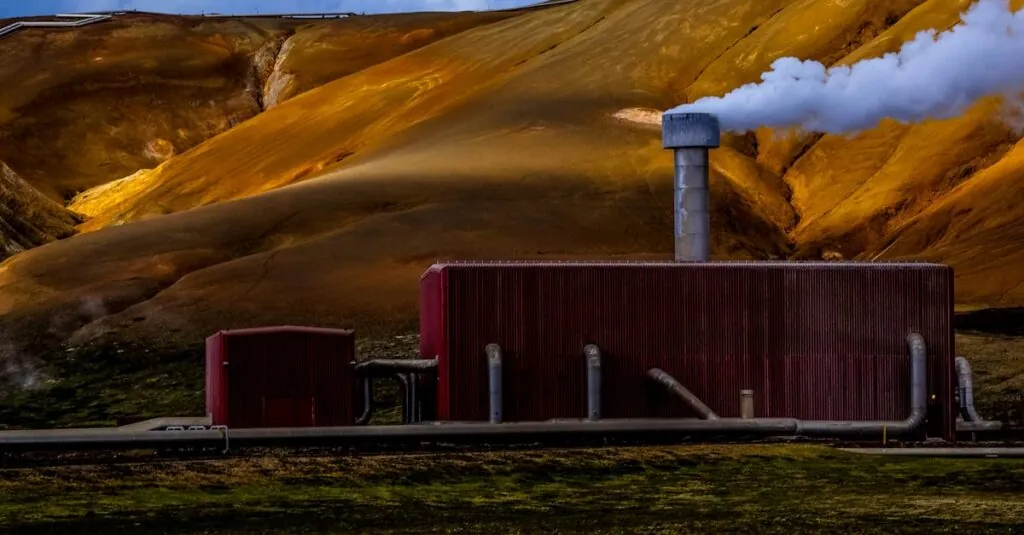Table of Contents
ToggleIn a world where renewable energy options are as plentiful as cat videos online, geothermal energy tech is the unsung hero waiting to steal the spotlight. Tapping into the Earth’s natural heat, it’s like giving Mother Nature a warm hug while keeping energy bills in check. Who wouldn’t want to harness the power of molten rock beneath their feet?
Imagine a future where homes are heated by the Earth itself, reducing carbon footprints and saving cash. It sounds like a sci-fi dream, but geothermal energy is already making waves. With innovations sprouting up faster than a coffee shop on every corner, it’s time to dig deeper into this hot topic. Buckle up as we explore the fascinating world of geothermal energy tech and why it might just be the coolest (or hottest) solution to our energy woes.
Overview of Geothermal Energy Tech
Geothermal energy technology captures heat from beneath the Earth’s surface. It generates electricity, regulates space heating, and supports industrial processes. This renewable resource offers lower emissions compared to fossil fuels, making it an eco-friendly alternative.
Geothermal systems can be classified into three main types: dry steam plants, flash steam plants, and binary cycle plants. Dry steam plants utilize steam directly from geothermal reservoirs. Flash steam plants, on the other hand, take high-pressure hot water, lower the pressure, and convert some of it to steam. Binary cycle plants transfer heat from geothermal water to a secondary liquid, which vaporizes and drives a turbine.
Geothermal power generation has a capacity ranging from 10 MW to over 1,000 MW, depending on the resource. Countries like the United States, Indonesia, and the Philippines lead in geothermal energy production. According to the International Renewable Energy Agency, global installed geothermal power capacity reached approximately 15,400 MW in 2021.
Innovations continue to enhance geothermal technology efficiency and accessibility. Enhanced geothermal systems utilize advanced drilling techniques, capturing geothermal energy from a broader range of locations. Additionally, research into improved heat exchangers and reservoir management optimizes energy extraction.
Geothermal heat pumps provide another avenue for utilizing geothermal energy. These systems harness stable ground temperatures for efficient heating and cooling in residential and commercial buildings. Implementations of these systems result in energy savings up to 70% compared to conventional heating methods.
Overall, advancements in geothermal energy technology contribute significantly to the renewable energy landscape. They demonstrate how harnessing the Earth’s natural heat can help mitigate climate change and promote sustainable energy solutions.
Types of Geothermal Energy Systems
Geothermal energy systems primarily fall into two categories: conventional geothermal power plants and enhanced geothermal systems. Each system serves a unique purpose in harnessing the Earth’s heat for energy production.
Conventional Geothermal Power Plants
Conventional geothermal power plants exploit naturally occurring high-temperature reservoirs of steam or hot water. Dry steam plants utilize steam directly from geothermal reservoirs to drive turbines. Flash steam plants convert high-pressure hot water into steam by reducing pressure. Binary cycle plants transfer heat from geothermal water to a secondary fluid through heat exchangers, allowing for lower temperature resources. These systems generate significant electricity, especially in regions with abundant geothermal activity, such as the United States, which leads in installed capacity.
Enhanced Geothermal Systems (EGS)
Enhanced geothermal systems enhance the extraction of geothermal energy from lower temperature rocks. EGS involves injecting water into fractured rock formations, where it’s heated by the Earth’s heat. The hot water returns to the surface, generating steam to drive turbines. Unlike conventional plants, EGS doesn’t require naturally occurring reservoirs, allowing deployment in a wider range of geographic locations. Recent advancements bolster EGS technology, promoting sustainable energy extraction and expanding geothermal’s role in meeting global energy demands.
Advantages of Geothermal Energy Tech
Geothermal energy technology offers a range of compelling advantages that enhance its appeal as a renewable resource. These benefits encompass environmental impacts and economic factors, making geothermal energy a vital player in the sustainable energy landscape.
Environmental Benefits
Geothermal energy significantly reduces greenhouse gas emissions. Unlike fossil fuels, it doesn’t release carbon dioxide during energy generation. The land footprint for geothermal installations tends to be small, minimizing ecological disturbance. Water use is typically low compared to conventional energy sources, with much of it being recycled within the system. Moreover, geothermal systems produce reliable baseload power, contributing to energy stability while decreasing reliance on intermittent sources like wind and solar.
Economic Advantages
The economic benefits of geothermal energy are substantial. Operational costs remain low once geothermal plants are established due to minimal fuel requirements. Geothermal installations can create local jobs during both construction and operation phases, boosting regional economies. In many cases, geothermal energy leads to lower utility bills for consumers, providing long-term cost savings. The inherent ability of geothermal systems to provide consistent energy also stabilizes energy prices, further enhancing its economic appeal.
Challenges Facing Geothermal Energy Tech
Geothermal energy, while promising, faces several significant challenges. These obstacles can impact its broader adoption and implementation.
Resource Location and Accessibility
Resource location poses a hurdle for geothermal energy projects. Geothermal resources are often concentrated in specific geographic regions, primarily near tectonic plate boundaries. As a result, areas like the United States, Indonesia, and the Philippines feature prominently in geothermal power generation. Limited geographic diversity restricts access for many potential users. Exploration and drilling in suitable regions can entail high initial costs, deterring investment. Additionally, remote locations may lack the necessary infrastructure to support energy transmission. Addressing these accessibility issues can enhance the development of geothermal projects in underrepresented areas.
Technological Limitations
Technological limitations restrict the efficiency of geothermal energy retrieval. Conventional geothermal power plants operate best with high-temperature reservoirs but may struggle with lower-temperature resources. Enhanced geothermal systems (EGS) aim to overcome this challenge, yet their effectiveness remains unproven at large scales. Concerns about reservoir sustainability also arise, as prolonged extraction can diminish resource longevity. Engineers continue to explore advanced heat exchangers and improved drilling techniques. Breakthroughs in technology can expand the feasibility of geothermal systems but require significant research and development efforts. Continued investment in innovation is essential for overcoming these barriers.
Future Trends in Geothermal Energy Tech
Geothermal energy technology continues to evolve, integrating cutting-edge innovations that enhance efficiency and scalability.
Innovations in Technology
New developments in geothermal energy tech promise to broaden its applications. Enhanced geothermal systems (EGS) significantly expand the potential for energy extraction by utilizing lower-temperature reservoirs, enabling systems to operate in a wider range of locations. Improved heat exchangers now facilitate more efficient heat transfer, maximizing energy conversion from the Earth’s natural heat. Moreover, advancements in drilling techniques reduce exploration costs and increase accessibility, making geothermal resources available in previously untapped areas. Continuous innovation drives the industry, ensuring that geothermal energy remains a viable and sustainable energy source.
Impact on Renewable Energy Landscape
Geothermal energy’s role in the renewable energy landscape is rapidly increasing. As countries seek to meet carbon reduction targets, geothermal offers a stable, reliable power source. The global installed capacity of approximately 15,400 MW demonstrates its significance in the renewable mix alongside solar and wind. Integration of geothermal systems with other renewable technologies enhances energy stability and resilience, addressing supply variability. Geothermal energy also contributes to job creation and local economic growth, reinforcing its value within energy strategies. Policymakers increasingly recognize its potential, encouraging investments and fostering further research, creating a more sustainable energy future.
Conclusion
Geothermal energy technology stands at the forefront of sustainable energy solutions. Its ability to harness the Earth’s heat offers a reliable and eco-friendly alternative to traditional energy sources. As advancements continue to emerge in drilling techniques and system efficiency, the potential for broader adoption increases.
The commitment to overcoming existing challenges will pave the way for a more accessible and economically viable geothermal landscape. With growing recognition from policymakers and investors, geothermal energy is poised to play an essential role in achieving global carbon reduction goals. This innovative technology not only promises to stabilize energy costs but also contributes significantly to a cleaner and more sustainable future.




